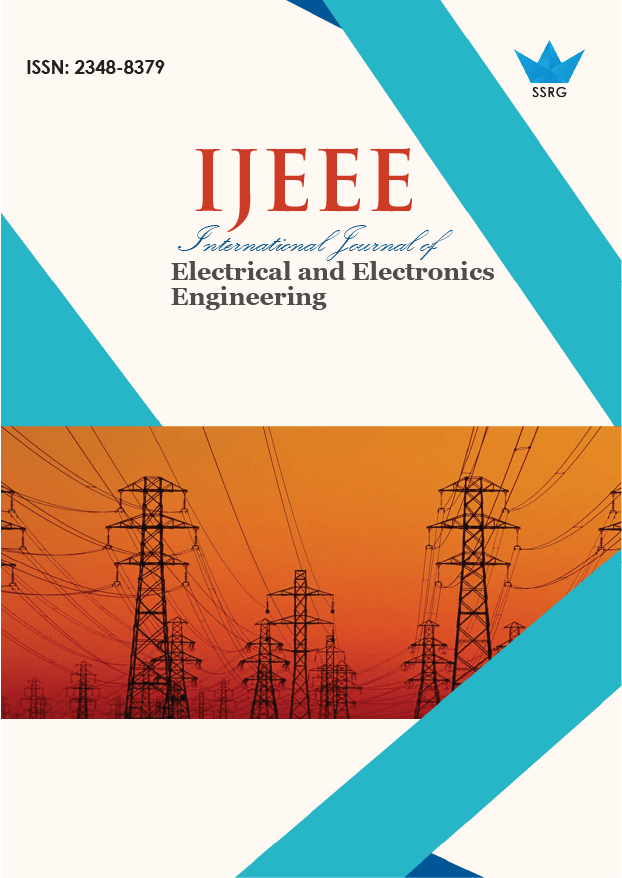Design and Implementation of a Wireless Power Transfer (WPT) System for Autonomous Power Supply to Remote Weather Stations Using Yagi Antennas at 2.45 GHz

| International Journal of Electrical and Electronics Engineering |
| © 2025 by SSRG - IJEEE Journal |
| Volume 12 Issue 9 |
| Year of Publication : 2025 |
| Authors : Emily Elizabeth Mirian Corrales Miranda, David Llamoca Sikos, Juan Guillermo Borja Murillo |
How to Cite?
Emily Elizabeth Mirian Corrales Miranda, David Llamoca Sikos, Juan Guillermo Borja Murillo, "Design and Implementation of a Wireless Power Transfer (WPT) System for Autonomous Power Supply to Remote Weather Stations Using Yagi Antennas at 2.45 GHz," SSRG International Journal of Electrical and Electronics Engineering, vol. 12, no. 9, pp. 159-167, 2025. Crossref, https://doi.org/10.14445/23488379/IJEEE-V12I9P116
Abstract:
This article presents the design and implementation of a long-distance Wireless Power Transfer (WPT) system operating in the 2.45 GHz ISM band, which allows continuous or intermittent power transmission via highly directional microwave links. The transmitter subsystem consists of an ADF4351 wideband frequency synthesizer tuned to 2.45 GHz, a medium-gain amplifier (SPF5189Z), and an RF2126 power amplifier, radiating through a high-gain Yagi antenna optimized in 4nec2, with the aim of transmitting sufficient and permitted power up to a maximum of 1 km for the constant or intermittent power supply of low-power electronic devices. At the receiving end, a tuned Yagi antenna captures the RF energy and conducts it to a rectenna composed of Schottky diodes, low-pass filters, and impedance coupling. The rectified energy is stored in supercapacitors and regulated by ultra-low start-up DC-DC converters (LTC3108) to supply power to a modern embedded weather system with a maximum consumption of 15mA. This architecture demonstrates WPT's technical feasibility and sustainability in the far field for low-power applications in remote areas, reducing dependence on batteries and solar panels, minimizing maintenance, and increasing operational reliability in hostile or isolated environments.
Keywords:
Wireless Power Transfer (WPT), Rectenna, Yagi antenna, Energy harvesting, Remote weather stations.
References:
[1] Fayrouz A. Omara et al., “Design of 2.45 GHz Rectifier for Low-Power RF Energy Harvesting Applications,” Microsystem Technologies, vol. 31, no. 7, pp. 1687-1699, 2025.
[CrossRef] [Google Scholar] [Publisher Link]
[2] T. Sathiyapriya, and R. Sudhakar, “Design of Circularly Polarized Koch Snowflake Fractal Antenna with Schottky Band Diode Rectifiers for RF Energy Harvesting Applications,” International Journal of Communication Systems, vol. 38, no. 5, 2025.
[CrossRef] [Google Scholar] [Publisher Link]
[3] Santosh Kumar Bairappaka et al., “A Dual-Band Dual-Polarized Rectenna for Efficient RF Energy Harvesting in Battery-Less IoT Devices with Broad Power Range,” International Journal of Communication Systems, vol. 38, no. 3, 2025.
[CrossRef] [Google Scholar] [Publisher Link]
[4] Haoyu Jiang, Zihan Wu, and Hao Min, “A -31 dBm Sensitivity High-Efficiency RF Energy Harvesting System with Burst Charging Mode for IoT Applications,” IEEE Transactions on Circuits and Systems I Regular Papers, vol. 72, no. 7, pp. 3215-3225, 2025.
[CrossRef] [Google Scholar] [Publisher Link]
[5] Yacine Boussaadia, Mohamed Tellache, and Fayçal Amrani, “A Novel High-Gain Rectenna for Wireless Power Transmission (WPT) Applications,” International Journal of Communication Systems, vol. 38, no. 9, 2025.
[CrossRef] [Google Scholar] [Publisher Link]
[6] Liu Shiqi et al., “A Novel Flexible Analysis Approach of Recirculating Cooling Water System Integrated Cooling Tower and Cooling Water Network,” Applied Thermal Engineering, vol. 265, 2025.
[CrossRef] [Google Scholar] [Publisher Link]
[7] Gabriel Koubar et al., “A Comprehensive Numerical Analysis of a 2.45 GHz Energy Harvesting Rectenna System and a Proposal for a Figure of Merit for Rectenna Systems” Electronics, vol. 14, no. 4, pp. 1-19, 2025.
[CrossRef] [Google Scholar] [Publisher Link]
[8] Akib Jayed Islam et al., “Optimized Rectenna Design for Wireless Power Transfer in Implantable Systems,” 2025 Devices for Integrated Circuit (DevIC), Kalyani, India, pp. 772-777, 2025.
[CrossRef] [Google Scholar] [Publisher Link]
[9] Deepak Sood, Manoj Kumar, and Jagpal Singh Ubhi, “A DC Combining-Free Miniaturized Mirror-Like Rectenna System with Full-Wave Rectification for Robust Wireless Power Transfer in IoT at 2.45 GHz,” IEEE Microwave and Wireless Technology Letters, vol. 35, no. 4, pp. 448-451, 2025.
[CrossRef] [Google Scholar] [Publisher Link]
[10] Jian Liu, Bing Xi Liu, and Ze Fan Lu, “Design of a Dual-Band Polarization-Reconfigurable Rectenna for Radio Frequency Energy Harvesting,” IEEE Antennas and Wireless Propagation Letters, vol. 24, no. 6, pp. 1412-1416, 2025.
[CrossRef] [Google Scholar] [Publisher Link]
[11] Yudi April Nando, and Wan-Young Chung, “Enhancing RF Energy Harvesting and Wireless Power Transfer with GAN-Optimized 3D Quasi-Yagi Antenna” 2024 IEEE Wireless Power Technology Conference and Expo (WPTCE), Kyoto, Japan, pp. 454-458, 2024.
[CrossRef] [Google Scholar] [Publisher Link]
[12] Yuchen Ma et al., “Combined Magnetoelectric/Coil Receiving Antenna for Biomedical Wireless Power Transfer” IEEE Journal of Electromagnetics RF and Microwaves in Medicine and Biology, vol. 9, no. 1, pp. 15-26, 2025.
[CrossRef] [Google Scholar] [Publisher Link]

 10.14445/23488379/IJEEE-V12I9P116
10.14445/23488379/IJEEE-V12I9P116